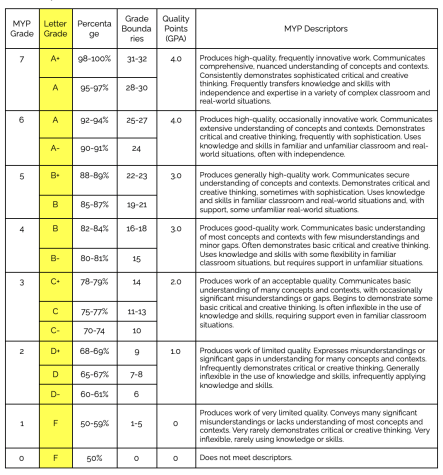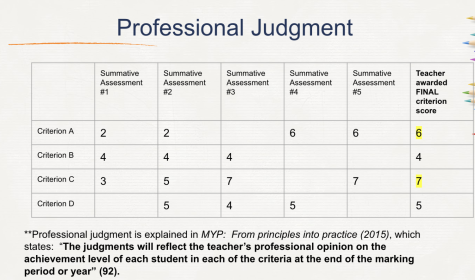Breaking down Standards Based Grading
November 22, 2021
The Standard Based Grading system is rooted in intentional focus on growth, rather than a letter grade. This philosophy of SBG is derived from International Baccalaureate practices. Meridian uses the 1-8 grading scale so we are aligned with other SBG schools, and the IB practices of formative and summative assignments are the main emphasis of the new system. The system serves to change the perspective that students use to understand concepts and complete assignments. Rather than focusing on percentages and letter grades, Standards Based Grading emphasizes growth by utilizing formatives and summatives as well as multiple criterias to measure skills.

IB Middle Years Programme Coordinator Rory Dippold used a helpful metaphor to describe formatives, summatives, and the importance of building skills. He said, “We want students to look at their learning from the lens of a sport or play: before you play a game you practice or scrimmage and receive feedback from a coach.”
There are two different MYP scales that are used as the basis of the grades students receive. The 0-8 scale is used for individual assignments, including summative and formative assessments. The final grade for the school year is formulated by adding up each criterion to make a number out of 32 (for 4 criteria). That number is then used to establish what score on the 1-7 scale is received. The 1-7 scale is the cumulative score for the end of the year. The teacher then converts this numerical grade to a letter grade to make the collegiate review of students seamless.
Dr. Dippold said that “the MYP requirement is that each criteria needs to be assessed twice a year at minimum.”
As stated before, students will receive a letter conversion of their 1-7 grade. This grade is influenced by criterion, determined by teachers reviewing a student’s growth throughout the year. The grade is not an average of the scores.
For example, if a student scored 5s and 6s in the first semester in Criterion C then scored 7s and 8s in the second semester, their score would reflect a 7 or 8 for Criterion C for the year. Dr. Dippold said, “[SBG] is about growth. It’s not about the averages.”

As discussed above, the conversion from SBG’s numerical score to traditional, A-F score is primarily for college application, transcripts, and GPAs. However, this grading system emphasizes that while students are in high school, they should focus their attention on the development of skills, applying feedback, and acquiring solid understanding of material rather than worrying about final grades. In other words, by putting these practices into application, students should end up earning a good grade for their overall year.
Overall, the MYP and standards based grading systems value the importance of building skills throughout the year. It encourages students and their parents to worry less about the numeral grade but instead growth throughout the year. “We want students to really practice and hone in on skills, and MYP is very skill based. Not just facts, but how you apply those facts,” said Dr. Dippold.









